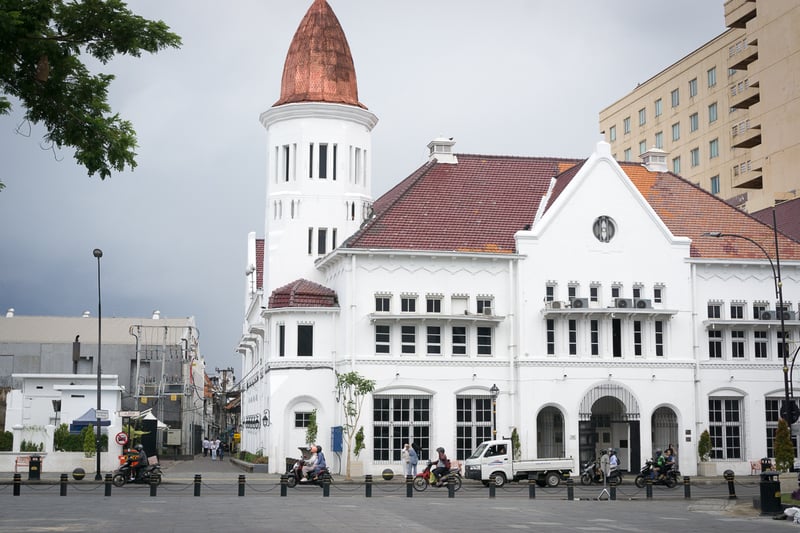SURABAYA, Indonesia (CN) — Follow the wide road into central Surabaya, Indonesia’s second-largest city, and large white European-style buildings begin to emerge, one after another.
This is Surabaya’s Old City, or Kota Lama as locals call it. From the 18th to the mid-20th century, Surabaya was the biggest city in what was then the Dutch East Indies, a competitor to other major Asian trading posts of the time. The proof is in these old buildings, which once served as banks, packhouses, production facilities and extravagant nightlife clubs for the city’s European elites.
For decades after independence, these buildings sat abandoned, like ghosts of a colonial past. That’s changed in recent months, as many have come to see Kota Lama as key to bringing in tourists and boosting Surabaya’s economy.
In July, local officials formally unveiled the revitalized district. A few months in, they say they’re happy with the results.
“We see this initiative as an opportunity for entrepreneurs to contribute directly to creating a new economic center for Surabaya,” Ali Affandi, chairman of the Surabaya City Chamber of Commerce and Industry, told the Indonesian news agency Antara earlier this month.
Zoom in on where tourists visit in the Indonesian archipelago, and East Java has often been overlooked. Instead, foreign visitors flock to the capital of Jakarta, the artisan city of Yogyakarta and the resort island of Bali.


That could be changing. In July 2024, East Java saw around 70% more visitors compared to July 2023, according to the East Java Central Statistics Agency.
Zulkipli, director of the agency, attributes much of that growth to renewal projects in Kota Lama. “This has quite an impact on tourism in East Java,” he told Antara in September, citing draws like traditional markets and guided tours through the old town.
Also known as The City of Heroes, Surabaya was the birthplace of modern Indonesia. It was here in 1945 where revolutionaries first proclaimed independence, challenging the Dutch rulers who had held power since the 1600s.
In Old Town Surabaya, the streets are paved with shiny cobblestones. Tropical plants grow along historic white walls. But the Indonesians here today are no longer just servants or laborers. Instead, they relax among the revitalized colonial buildings, sipping tea and coffee and taking in the vibes.
One might expect that Indonesians would want these buildings gone. They are, after all, remnants of oppressive colonial rule. But when Dutch researcher Remco Vermuelen looked into the matter, he found that the opposite was true.

Surveying around 700 locals, a majority of them — 60% — had positive views of the buildings. Around 70% wanted them to remain part of Surabaya’s urban fabric. Views on these colonial ruins were far more positive than those on Dutch rule itself. About 60% of respondents had negative views on Dutch colonialism, while 30% were neutral.
“In the Netherlands, there’s an ongoing discussion and debate about colonial history,” said Vermeulen, a Ph.D. candidate at Erasmus University Rotterdam who’s studying the legacy of colonialism with a focus on Indonesian cities. “At the same time, in Indonesia, all these Dutch colonial urban spaces, buildings and public spaces are being revitalized. There are a lot of young people hanging out there.”
“For me, that’s an interesting development,” he added. He was struck by the way the Netherlands and Indonesia were grappling with their colonial past in different ways. “It’s interesting that although [Indonesians] don’t like the history, they do like the buildings.”
Just off the main road in Surabaya are secluded and narrow alleys where merchants, workers and transporters once labored for the profit of the Netherlands.
Roam around these streets these days, and one will notice how vibrant and lively they become after school hours. Young Indonesians swarm the neighborhood for the cultural experience or — like young people everywhere — to take the perfect Instagram photo. It’s a stark contrast to a decade ago, when the buildings of Kota Lama sat mostly unabandoned.
The scene marks a new era in Surabaya, in which locals are coming to appreciate these remnants of their colonial past. Case in point: Soon after the revitalization efforts were unveiled, hundreds of volunteers came out to help clean up the neighborhood.
In his research, Vermeulen is looking into the way locals are reclaiming these spaces for themselves. “Some Indonesians say that these buildings represent their ancestors, because their ancestors were the ones who built them, not the Dutch or Europeans,” Vermeulen said, recalling some of the comments he got from local Indonesians during fieldwork. “We conquered in the end. We were victorious,” one person told him. “We are still here, and the Dutch are not.”
